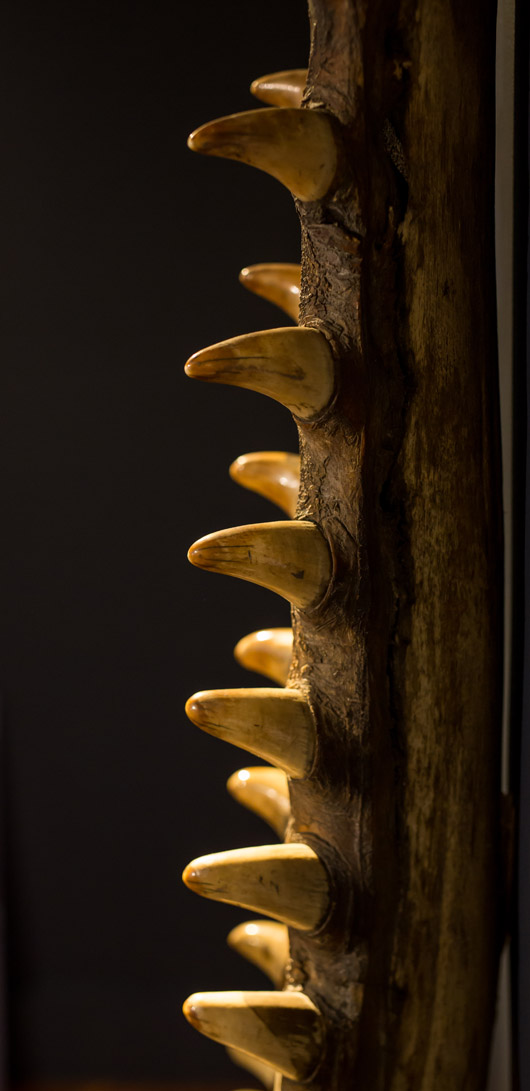On Tuesday, Jan. 19, 1869 a fly landed on six-year-old Laura Jernegan’s finger and she made note of it in her journal. “Thare is a fly on my finger,” she wrote. “He has flew of now.” Laura’s journal, never more than a few lines a day, covered three years she spent on a whaling ship with her family.

The Jernegans from Edgartown sailed to Hawaii chasing sperm whales and little Laura’s diary and progressing penmanship is now a permanent part of Martha’s Vineyard Museum’s collection. It is also a centerpiece of In the Giant’s Shadow: Whaling and Martha’s Vineyard, a new exhibit that opens on Friday.
In the Giant’s Shadow steps away from the familiar captains whose names decorate doorways in Edgartown and Vineyard Haven to explore the characters and figures from the heyday of Island whaling that often go unnoticed.
“Whaling is such a part of the Vineyard narrative. It’s fascinating and compelling and our collection is so strong,” said assistant curator Anna Carringer. “We wanted to share stories of folks involved — going past the old white whaling captain.”
In 1850 on the Vineyard, 686 males listing their occupation as “mariner” compared to 342 farmers on the census. It is possible the Vineyard had more whaling masters per capita than any other place in the world, according to the Martha’s Vineyard Museum. But the whaling industry affected the entire Island, not just the men who set sail.
During the mid-1800s the Vineyard was populated by women who took charge in a time when they weren’t often offered the reins. A young woman named Virginia Luce married a whaling captain when she was 19. Though her house was decorated with fineries brought from around the world — a Chinese ginger jar, a delicate seed bracelet — she spent most of her life apart from her husband, and three of her sons were lost at sea. A portrait of Virginia is included in the exhibit, hanging over a few of her trinkets from far away.
“The strength of the community of women here, these geographically isolated women whose husbands are away, was astounding,” Ms. Carringer said.
Though at times left behind, the wives were not forgotten, Ms. Carringer said. Jared Jernegan wrote love letters to his wife Helen, begging her to meet him in the next port town. Recordings of his love letters can be heard at the exhibit and a model of his ship, the Roman, is on display as well.
“It’s misconception that whaling was just guys getting dirty and making money, this goes against that,” said Ms. Carringer. “To read one of these letters, he really misses her.”
Others emerging into the spotlight are people of color who were innovators in the industry.
Lewis Temple designed a toggle-headed harpoon that buoyed the success of a throw. Harpoons possibly designed by Mr. Temple hang from the ceiling of the exhibit. The exhibit also tells the story of William A. Martin, the only black whaling captain from the Vineyard, though the museum has no physical objects linked to him.
“It’s significant that there isn’t a portrait of [William Martin]. We have nothing in the collection, just anecdotal history,” Ms. Carringer said. Wampanoag whalers like Amos Haskins and Amos Smalley, Portuguese sailors, and African Americans all contributed to the industry, but few were so carefully recorded and remembered as their white counterparts.

Along with stories about individuals, the exhibit showcases the jaw bone of a juvenile sperm whale next to a collection of scrimshaw. Bottles of whale oil are lined up from crude to refined, each carefully hand labeled. Ms. Carringer said the dichotomy of the whaling industry is always on the curators’ minds when they put together an exhibit.
“It’s hard not to celebrate certain aspects: it created music, an art form, it created Water street and William street,” she said. “But we also recognize it is a horrible industry that travelled the world and took without considering the effects.”
Though the space for this exhibit is small, Ms. Carringer said In the Giant’s Shadow will give a taste for under-explored whaling stories and hopefully encourage more stories from those not-so-long-forgotten to emerge into the spotlight.
In the Giant’s Shadow: Whaling and Martha’s Vineyard opens on Friday, April 22 with a reception from 4 p.m. to 6 p.m. Admission is free to members; admission for non-members is $8 for adults, $7 for seniors, $5 for children 6 to 12 and free for children under the age of 6. For more information visit mvmuseum.org.








Comments (1)
Comments
Comment policy »